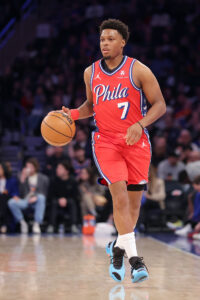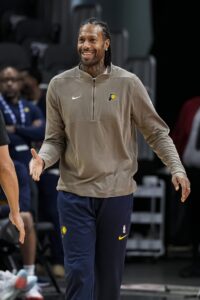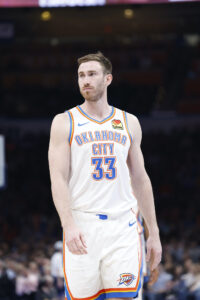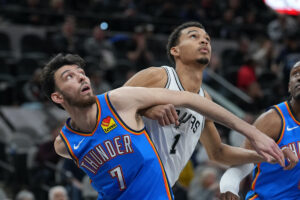A year ago, entering the 2023 NBA draft, just one of the 14 picks in the lottery had changed hands — the Magic owned Chicago’s first-rounder.
In 2024, there’s a viable scenario in which half of of the 14 picks in the lottery will be controlled by new teams.
With just over a month left to go in the 2023/24 season, let’s check in to see where things stand with the traded picks for the 2024 draft and the protections that apply to them…
Picks that won’t change hands (or swaps that won’t be exercised):
- Wizards‘ pick (top-12 protected) to Knicks
- Pistons‘ pick (top-18 protected) to Knicks
- Hornets‘ pick (top-14 protected) to Spurs
- Trail Blazers‘ pick (top-14 protected) to Bulls
- Wizards‘ right to swap picks with Suns
- Grizzlies right to swap picks with Suns or Wizards (least favorable)
The Wizards, Pistons, Hornets, and Trail Blazers are currently four of the five worst teams in the NBA (the fifth, San Antonio, unconditionally controls its own first-rounder). While it’s not ideal that they’ve each traded away a first-round pick, the good news is that all four clubs are locks to hang onto those first-rounders in 2024. Even with extremely bad lottery luck, none of them are falling out of the top 10.
Unfortunately, all four of those teams’ draft obligations will simply be pushed back a year, so they’ll be in danger of losing their 2025 first-round picks if they don’t once again fall in their respective protected ranges.
The Wizards obviously won’t be using their ability to swap first-round picks with the Suns, who are currently 27.5 games ahead of them in the standings. That leaves Memphis the option to swap first-rounders with Phoenix, but the Grizzlies have the league’s sixth-worst record, so they won’t be taking advantage of that ability either.
Picks that might change hands (or swaps that might be used):
- Raptors‘ pick (top-six protected) to Spurs
- Rockets‘ pick (top-four protected) to Thunder
- Jazz‘s pick (top-10 protected) to Thunder
- Kings‘ pick (top-14 protected) to Hawks
- Lakers‘ pick (unprotected) to Pelicans
- Pelicans‘ right to swap picks with Bucks
The Spurs could add a second top-10 pick if the Raptors‘ first-rounder lands outside the top six. Toronto currently has the NBA’s seventh-worst record and even “passing” Memphis in the reverse standings for the sixth-worst record wouldn’t offer the Raptors any assurances. In that scenario, they’d still be more likely to fall out of the top six and lose their pick (54.2%) than to remain in the top six and keep it (45.8%).
The Thunder, meanwhile, won’t be in the lottery themselves for the first time in several years, but they’re still well positioned to control a top-10 selection. If the season ended today, the Rockets would be No. 9 in the lottery standings, giving them just a 20.2% chance of moving into the top four and hanging onto their first-rounder.
Getting lucky in the lottery wouldn’t just allow Houston to keep its own pick — it would allow the team to extinguish that obligation to Oklahoma City by sending its 2025 second-rounder instead. However, the Rockets do still owe the Thunder a separate 2026 first-rounder.
The Jazz‘s 2024 first-round pick could go either way. They currently have the 10th-worst record in the NBA at 28-35, but they’re neck-and-neck with Houston (27-35) and Atlanta (28-34), so it’s not out of the question that the Thunder end up getting Utah’s pick too. For what it’s worth, finishing with the league’s 10th-worst record would put the Jazz in a strong position to keep their first-rounder, but wouldn’t guarantee it, since a team 11th or lower in the lottery standings could push them out of the top 10 by winning a top-four pick on lottery night.
If the season ended today and the Kings won one of two play-in games, their pick would likely be either 19th or 20th overall and would be sent to the Hawks. But finishing in play-in territory doesn’t lock in a playoff spot, especially given the potential play-in opponents currently bunched up with Sacramento in the standings. Even if they finish with the Western Conference’s seventh-best record, the Kings would move into the lottery if they’re eliminated in the play-in tournament, which would allow them to hang onto their selection.
As for the Pelicans, they may face a difficult decision on the Lakers‘ first-rounder, which they have the option to defer to 2025. Los Angeles is currently at No. 9 in the West, so that pick could land in the lottery. And even in a best-case scenario for the Lakers, it’s likely to be no lower than the mid-to-late teens. That might be hard to pass up, but this year’s draft class is viewed as weak and there are no assurances the Lakers will be any better in 2024/25, so New Orleans will be tempted to defer.
Finally, the Pelicans also have the ability to swap their own first-round pick for the Bucks‘ selection. New Orleans trails Milwaukee by 3.5 games in the standings, so if the season ended today, the Pels would stay at No. 23 and pass on the Bucks’ No. 25 pick. But if they can make up ground on Milwaukee in the standings, that swap option remains a possibility.
That picks that will (or are at least highly likely to) change hands:
- Nets‘ pick (unprotected) to Rockets
- Warriors‘ pick (top-4 protected) to Trail Blazers
- Pacers‘ pick (top-3 protected) to Raptors
- Mavericks‘ pick (top-10 protected) to Knicks
- Clippers‘ pick (unprotected/conditional) to Wizards or Jazz
- Thunder‘s pick (unprotected/conditional) to Wizards or Jazz
The Rockets may not end up with their own first-round pick, but they should still have a top-10 selection. The Nets‘ first-rounder projects to be No. 8 overall, and it’s going to Houston unconditionally.
The Warriors‘ and Pacers‘ picks currently project to be No. 14 and 15 overall, but if those teams miss the playoffs, there’s a long-shot scenario in which they get lucky on lottery night and move into the top four (or top three, in Indiana’s case). It’s extremely unlikely though, so the Trail Blazers and Raptors can probably plan on controlling those picks.
The Mavericks are eighth in the West and are in some danger of missing the playoffs for a second straight year, but even in that scenario, they would almost certainly place no higher than 11th or 12th in the lottery standings, creating extremely long odds for a move into the top four. It’s very likely the Knicks will get Dallas’ pick this year.
The Wizards will get whichever of the Clippers‘ or Thunder‘s first-round picks is more favorable, while the Jazz will get the least favorable of the two. Right now, that means L.A.’s pick (No. 26) would go to Washington and Oklahoma City’s (No. 28) would go to Utah, but the two teams are separated by just 2.5 games in the standings, so nothing’s locked in yet.
 Danilo Gallinari: Signed with Bucks
Danilo Gallinari: Signed with Bucks As is the case with Bird rights, a player’s clock stops when he’s released by a team and clears waivers, but it would pick up where it left off if he re-signs with that same team down the road without joining another club in the interim. For instance,
As is the case with Bird rights, a player’s clock stops when he’s released by a team and clears waivers, but it would pick up where it left off if he re-signs with that same team down the road without joining another club in the interim. For instance,  For instance, the Thunder will hold
For instance, the Thunder will hold  It was Wembanyama who got the upper hand in the latest chapter of the budding rivalry between the two young bigs on Thursday night. The No. 1 overall pick, who led the Spurs to an upset win over the Thunder, became the first player in NBA history to record at least 25 points, 10 rebounds, five assists, five blocks, and five 3-pointers in a game, according to
It was Wembanyama who got the upper hand in the latest chapter of the budding rivalry between the two young bigs on Thursday night. The No. 1 overall pick, who led the Spurs to an upset win over the Thunder, became the first player in NBA history to record at least 25 points, 10 rebounds, five assists, five blocks, and five 3-pointers in a game, according to